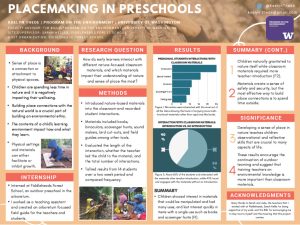Placemaking in Preschools
Place connections are key ways that people develop an affinity and care for the natural world. Facilitating place connections in early learners is an important step in raising a generation that prioritizes nature. For my capstone, I interned at Fiddleheads Forest School, an outdoor preschool in Washington Park Arboretum. The purpose of my capstone work was to analyze which types of materials should be included in outdoor preschools to best facilitate connections with nature. To do this, I introduced different nature-focused materials into the classroom and recorded the number, length, and quality of the children’s interactions with the materials. The materials included pages from standard bird field guides, a scavenger hunt with pictures ofdifferent ways to notice a bird (hearing, sight, etc.), sound makers that played different bird calls, binoculars, and bird cut-outs that were placed in trees around the classroom. I also had informal conversations with the students about their experiences in nature. The most prominent results from my research indicated that even with many different types of materials introduced, the children were still most interested in nature itself. These results are important because they point to the presence of materials in outdoor classrooms to be for comfort and security. Building connections with nature is best done by interacting with nature itself through the use of the 5 senses. These experiences teach valuable observational skills that extend to many other parts of life.
